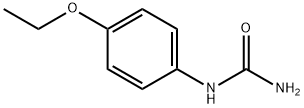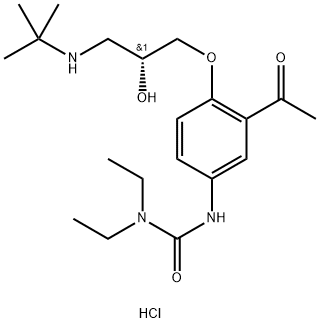DULCIN
- CAS NO.:150-69-6
- Empirical Formula: C9H12N2O2
- Molecular Weight: 180.2
- MDL number: MFCD00025431
- EINECS: 205-767-7
- SAFETY DATA SHEET (SDS)
- Update Date: 2023-10-27 15:37:12

What is DULCIN?
Chemical properties
Off-White Solid
The Uses of DULCIN
Dulcin is a non-nutritive sweetener. Dulcin is a sweet analgesic for use in medical procedures or treatments.
What are the applications of Application
Glycosine is a chemical also known as N-(4-Ethoxyphenyl)urea and 1-(4-ethoxyphenyl) urea
Definition
ChEBI: Dulcin is a member of ureas.
Production Methods
4-Ethoxyphenylurea, dulcin, is produced from the addition of potassium cyanate to p-phenetidine hydrochloride in aqueous solution at room temperature or from mixing urea and p-phenetidine hydrochloride to a mixture of hydrochloric acid and glacial acetic acid.
General Description
White crystals.
Air & Water Reactions
Partially decomposes on heating in water; hydrolyzes in 0.1 N acetic acid. Slightly water soluble .
Reactivity Profile
DULCIN is an example of an amide. Amides react with azo and diazo compounds to generate toxic gases. Flammable gases are formed by the reaction of organic amides with strong reducing agents. Amides are very weak bases (weaker than water). Imides are less basic yet and in fact react with strong bases to form salts. That is, they can react as acids. Mixing amides with dehydrating agents such as P2O5 or SOCl2 generates the corresponding nitrile. The combustion of these compounds generates mixed oxides of nitrogen (NOx).
Safety Profile
Human poison by ingestion. Moderately toxic experimentally by ingestion. Human systemic effects by ingestion: somnolence, hallucinations, distorted perceptions, and changes in motor activity. In adults 20 to 40 g produces dizziness, nausea, methemoglobinemia, cyanosis, and hypotension. Questionable carcinogen with experimental tumorigenic data. When heated to decomposition it emits toxic fumes of NOx.
Properties of DULCIN
| Melting point: | 160-161℃ |
| Boiling point: | 313.03°C (rough estimate) |
| Density | 1.199 |
| refractive index | 1.5373 (estimate) |
| storage temp. | Sealed in dry,2-8°C |
| solubility | DMSO (Slightly), Methanol (Slightly) |
| form | Solid |
| color | White to Off-White |
| Water Solubility | 1.21g/L(21 ºC) |
| λmax | 289nm(EtOH)(lit.) |
| Merck | 14,3464 |
| CAS DataBase Reference | 150-69-6 |
| IARC | 3 (Vol. 12, Sup 7) 1987 |
| EPA Substance Registry System | Dulcin (150-69-6) |
Safety information for DULCIN
| Signal word | Warning |
| Pictogram(s) |
 Exclamation Mark Irritant GHS07 |
| GHS Hazard Statements |
H315:Skin corrosion/irritation H319:Serious eye damage/eye irritation |
| Precautionary Statement Codes |
P280:Wear protective gloves/protective clothing/eye protection/face protection. P302+P352:IF ON SKIN: wash with plenty of soap and water. P305+P351+P338:IF IN EYES: Rinse cautiously with water for several minutes. Remove contact lenses, if present and easy to do. Continuerinsing. P332+P313:IF SKIN irritation occurs: Get medical advice/attention. P337+P313:IF eye irritation persists: Get medical advice/attention. |
Computed Descriptors for DULCIN
New Products
4-AMINO-TETRAHYDRO-PYRAN-4-CARBOXYLIC ACID HCL 4-(Dimethylamino)tetrahydro-2H-pyran-4-carbonitrile 4-Aminotetrahydropyran-4-carbonitrile Hydrochloride (R)-3-Aminobutanenitrile Hydrochloride 3-((Dimethylamino)methyl)-5-methylhexan-2-one oxalate 1,4-Dioxa-8-azaspiro[4.5]decane 5-Bromo-2-nitropyridine Nimesulide BP Aceclofenac IP/BP/EP Diclofenac Sodium IP/BP/EP/USP Mefenamic Acid IP/BP/EP/USP Ornidazole IP Diclofenac Potassium THOMAIND PAPER PH 2.0 TO 4.5 1 BOX BUFFER CAPSULE PH 9.2 - 10 CAP SODIUM CHLORIDE 0.1N CVS ALLOXAN MONOHYDRATE 98% PLATINUM 0.5% ON 3 MM ALUMINA PELLETS (TYPE 73) LITHIUM AAS SOLUTION 2-Bromo-1-(bromomethyl)-3-chloro-5-nitrobenzene 2-Bromo-3-nitroaniline N-(3-Hydroxypropyl)-N-methylacetamide 3-Bromo-6-chloropyridazine 4-ethyl-3-nitrobenzoic acidRelated products of tetrahydrofuran
![N1-(2,6-DICHLORO-3-PYRIDYL)-2-([4-(2,3-DIHYDRO-1,4-BENZODIOXIN-6-YL)-5-OXO-4,5-DIHYDRO-1H-1,2,4-TRIAZOL-3-YL]SULFANYL)ACETAMIDE](https://img.chemicalbook.in/StructureFile/ChemBookStructure4/GIF/CB1386651.gif)







You may like
-
 N-(4-Ethoxyphenyl)urea 98.00% CAS 150-69-6View Details
N-(4-Ethoxyphenyl)urea 98.00% CAS 150-69-6View Details
150-69-6 -
 (4-Ethoxyphenyl)urea CAS 150-69-6View Details
(4-Ethoxyphenyl)urea CAS 150-69-6View Details
150-69-6 -
 1-(4-Ethoxyphenyl)urea CAS 150-69-6View Details
1-(4-Ethoxyphenyl)urea CAS 150-69-6View Details
150-69-6 -
 1823368-42-8 98%View Details
1823368-42-8 98%View Details
1823368-42-8 -
 2-(3-(tert-butyl)phenoxy)-2-methylpropanoic acid 1307449-08-6 98%View Details
2-(3-(tert-butyl)phenoxy)-2-methylpropanoic acid 1307449-08-6 98%View Details
1307449-08-6 -
 Ethyl 3-(furan-2-yl)-3-hydroxypropanoate 25408-95-1 98%View Details
Ethyl 3-(furan-2-yl)-3-hydroxypropanoate 25408-95-1 98%View Details
25408-95-1 -
 2-Chloro-5-fluoro-1-methoxy-3-methylbenzene 98%View Details
2-Chloro-5-fluoro-1-methoxy-3-methylbenzene 98%View Details
1805639-70-6 -
 Lithium ClavulanateView Details
Lithium ClavulanateView Details
61177-44-4